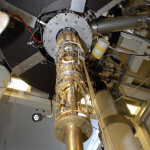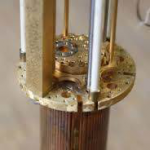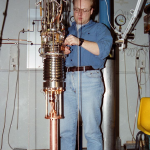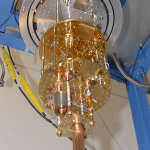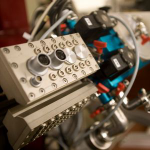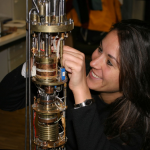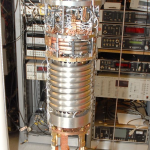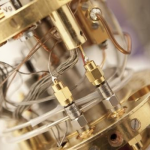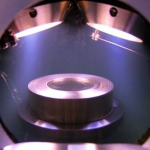

- Photon Transport in a Bose-Hubbard Chain of Superconducting Artificial Atoms
G. P. Fedorov et al., Phys. Rev. Lett. 126, 180503 (2021) - Path-Dependent Supercooling of the
He3 Superfluid A-B Transition
Dmytro Lotnyk et al., Phys. Rev. Lett. 126, 215301 (2021) - Superconductivity in an extreme strange metal
D. H. Nguyen et al., Nat Commun 12, 4341 (2021) - High-Q Silicon Nitride Drum Resonators Strongly Coupled to Gates
Xin Zhou et al., Nano Lett. 21, 5738-5744 (2021) - Measurement of the 229Th isomer energy with a magnetic micro-calorimeter
T. Sikorsky et al., Phys. Rev. Lett. 125 (2020) 142503
Towards FAIR: first measurements of metallic magnetic calorimeters for high-resolution x-ray spectroscopy at GSI
D. Hengstler, M. Keller, C.Schötz, J. Geist, M. Krantz, S. Kempf, L. Gastaldo, A. Fleischmann, T. Gassner, G. Weber, R. Maertin, T. Stoehlker, C. Enss
Metallic magnetic calorimeters are energy dispersive particle detectors that are operated at temperatures below  . Applied to x-ray spectroscopy they combine the high energy resolution of crystal spectrometers with the large energy bandwidth of semiconductor detectors. After the absorption of a photon its energy is converted into heat. A paramagnetic alloy converts the temperature change into a change of magnetization that is read out by a sensitive superconducting quantum interference device magnetometer. With such a metallic magnetic calorimeter we performed two successful measurements at the internal gas target of the experimental storage ring at GSI. In the first beamtime lithium-like Au-ions were targeted on a N2 and a Xe gas target, respectively. In the second beamtime we observed a projectile beam of bare Xe ions interacting with a Xe gas target. In both experiments we achieved an energy resolution below
. Applied to x-ray spectroscopy they combine the high energy resolution of crystal spectrometers with the large energy bandwidth of semiconductor detectors. After the absorption of a photon its energy is converted into heat. A paramagnetic alloy converts the temperature change into a change of magnetization that is read out by a sensitive superconducting quantum interference device magnetometer. With such a metallic magnetic calorimeter we performed two successful measurements at the internal gas target of the experimental storage ring at GSI. In the first beamtime lithium-like Au-ions were targeted on a N2 and a Xe gas target, respectively. In the second beamtime we observed a projectile beam of bare Xe ions interacting with a Xe gas target. In both experiments we achieved an energy resolution below  from
from  to
to  . We were able to detect K-lines of Xe ions of different charge states, including the Lyman series up to Ly-η and could resolve the Ly-β-doublet in H-like Xe.
. We were able to detect K-lines of Xe ions of different charge states, including the Lyman series up to Ly-η and could resolve the Ly-β-doublet in H-like Xe.
Physica Spripta T166, 014054 (2015)
doi: 10.1088/0031-8949/2015/T166/014054
